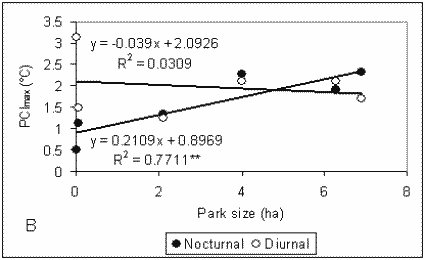
 |
||
| Scientists' Contributions | ||
EFFECTS OF URBAN PARK COOLING ON HUMAN WELL-BEING
by
L. Bacci 1, M. Morabito 2
1 Institute of Biometeorology, CNR, Florence, Italy, E-mail: l.bacci@ibimet.cnr.it
2 Dep. Soil Science and Plant Nutrition, University of Florence, Florence, Italy, E-mail: m.morabito@ibimet.cnr.it
Urban parks are usually areas cooler and more humid than surroundings as a consequence, mainly, to the transpiration activity of vegetation which converts a large part of available energy in latent heat flux, contrasting air temperature increase. In Mediterranean areas the cooling effect of vegetated areas has mainly a positive impact on human well-being during summer, mitigating the discomfort caused by sultry and torrid conditions. On the contrary, during winter season, park cooling effect can increase human discomfort caused by lower air temperature.
Nevertheless the different thermo-hygrometric behavior of vegetated areas in comparison with built areas is related to size and characteristics of green areas which affect also daily and seasonal trends. How this different behavior affects human comfort/discomfort level can be evaluated by applying biometeorological indexes. The latter can be either empirical equations that combine more meteorological parameters (usually air temperature, relative humidity and wind speed) or complex models based on the energy balance of the human body.
Florence (Italy), where there are the laboratories of Institute of Biometeorology, is a relative small town (about 380,000 inhabitants and a surface of about 102 km2) which has several parks and garden, mainly private, located in the fabric of city. For carrying out studies on green area microclimate and its effect on human well-being, six of these vegetated areas were chosen and equipped with meteorological sensors to measure air temperature and relative humidity (Fig.1). Florence has also an urban weather station located in the ancient center.
The size of the six vegetated areas taken into account ranged from 0.02 ha (courtyard) to about 7 ha (private park). Thermal differences between urban station and park/garden stations were calculated on hourly basis using data collected during the winter 2001-2002 and summer 2002.
The biometeorological indexes applied were: Apparent Temperature (Steadman R.G. 1979. The assessment of sultriness; Part I: A temperature-humidity index based on human physiology and clothing science. J. Applied Meteorol., 18: 861-873) for summer season and Scharlau Index (Scharlau, K., 1950, Einführung eines Schwülemasstabes und Abgrenzung von Schwülezonen durch Isohygrothermen, Erdkunde, 4, 188-201) for winter months. Both indexes use air temperature and relative humidity like input parameters.
Data analysis was performed considering nocturnal and diurnal hours separately.

Figure 1 - Position, size and altitude of weather stations.
The analysis of collected data showed that during winter the thermal difference between urban station and green area stations positively increased with the increase of park size both during diurnal and nocturnal hours (P = 0.05). During summer season a positive linear regression between thermal difference and green area size was found only during night. In fact, during summer diurnal hours, even small green areas with trees showed a relevant cooling effect not too different from the effect of larger areas (1.5°C vs. 2.3°C). A very marked cooling effect was pointed out by the vegetated courtyard, completely encircled by houses, that during summer daytime showed air temperatures of about 3°C lower than urban station (Fig.2). On the contrary to diurnal behavior, during the night, the courtyard had a temperature similar to urban station. The particular microclimatic behavior of courtyards which incorporate trees or elements like canvas awnings is the basis of the Spanish "patio" and of other similar architectural structure usually found in hot dry zones, like Egypt, Tunisia and Iraq.

Figure 2 - Mean of daily maximum thermal differences between urban station and green area stations (PCImax)
vs. green area size for summer season. ** P=0.05; * P=0.10.
The results of biometeorological index application reflected the different thermal behavior detected. In fact the cooling effect of larger green areas determined a reduction of severe discomfort conditions during summer and an increase of these during winter. Also small green areas showed a high capacity in reducing severe discomfort conditions during summer. Nevertheless the architectural element which showed the most comfortable thermohygrometric conditions in both season was the densely vegetate courtyard encircled by houses.
According to these results the study about green area microclimate and its effect on human well-being will concentrate mainly on small vegetated areas and courtyards with different physical characteristics. Furthermore air temperature changes by going from the core green area to the immediate surroundings will be studied and quantified.
| Back to the top |
 |
||
| Scientists' Contributions | ||